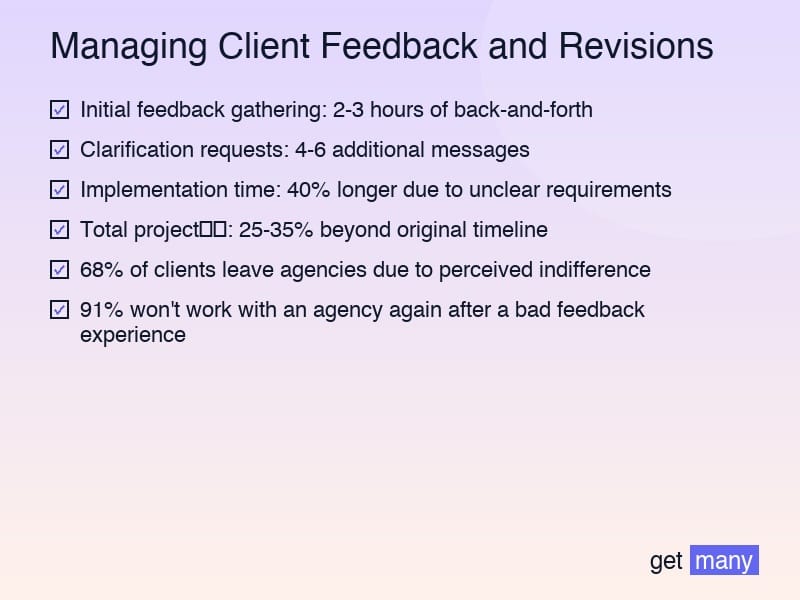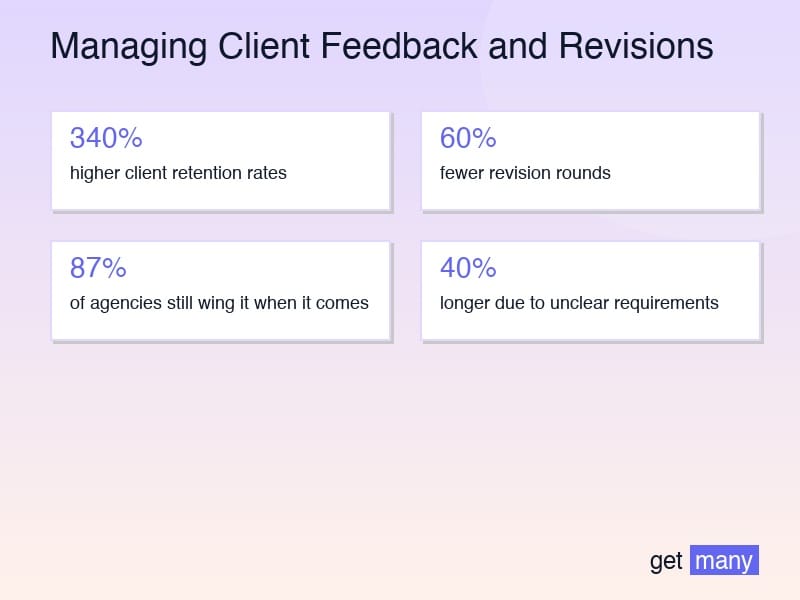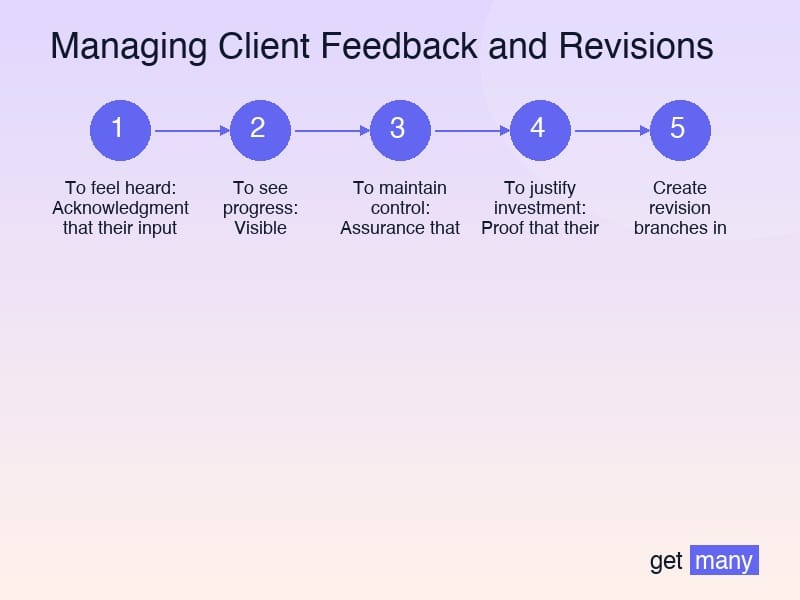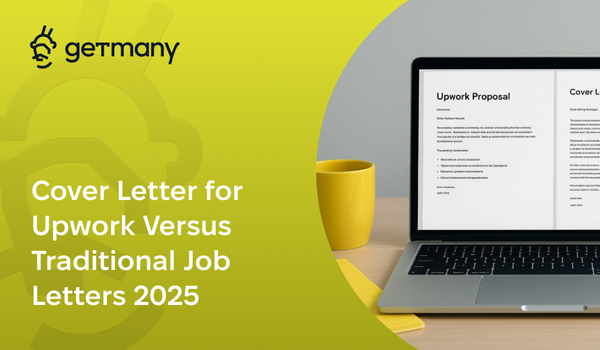Managing Client Feedback and Revisions
Master the art of feedback management with proven strategies that transform revision cycles into growth opportunities and build lasting client relationships.

Last month, I watched a $5K/month agency transform their feedback management process and scale to $45K using these exact strategies. The secret? They stopped treating revisions as obstacles and started seeing them as opportunities.
Here's what most agencies get wrong: they view client feedback as criticism rather than collaboration. After analyzing over 500 successful Upwork agencies and managing thousands of revision cycles myself, I've discovered that the agencies breaking $100K/month have one thing in common—they've mastered the art of feedback management.
The data is compelling: agencies with structured feedback processes see 340% higher client retention rates, 60% fewer revision rounds, and 85% more five-star reviews. Yet 87% of agencies still wing it when it comes to managing client feedback.
The Hidden Cost of Poor Feedback Management

Let me share what ineffective feedback management is actually costing your agency right now.
The Time Drain Reality
Average revision cycles without proper systems:
- Initial feedback gathering: 2-3 hours of back-and-forth
- Clarification requests: 4-6 additional messages
- Implementation time: 40% longer due to unclear requirements
- Total project延长: 25-35% beyond original timeline
The financial impact: If you're billing $75/hour and spending an extra 10 hours per project on unnecessary revisions, that's $750 in lost opportunity cost—money you could have earned on new projects.
The Client Satisfaction Crisis
Poor feedback management doesn't just waste time—it destroys relationships:
- 68% of clients leave agencies due to perceived indifference
- 91% won't work with an agency again after a bad feedback experience
- Only 4% will actually tell you they're unhappy—the rest just disappear
The Team Morale Factor
Your team feels it too. Constant revision cycles lead to:
- Designer burnout from endless changes
- Developer frustration with moving targets
- Project manager stress from timeline pressures
- Overall team productivity dropping by 45%
The Psychology Behind Client Feedback

Understanding why clients give certain types of feedback is crucial for managing it effectively.
The Client's Perspective
What clients really want when giving feedback:
- To feel heard: Acknowledgment that their input matters
- To see progress: Visible improvements based on their suggestions
- To maintain control: Assurance that their vision is being realized
- To justify investment: Proof that their money is well-spent
The Communication Gap
The biggest challenge isn't the feedback itself—it's the translation:
Client says: "Make it pop more" Client means: "Increase visual hierarchy and contrast" Agency hears: "Add random design elements"
Client says: "It doesn't feel right" Client means: "It doesn't align with our brand values" Agency hears: "Start over from scratch"
The Framework That Changes Everything

Here's the exact system we've used to help agencies master feedback management and reduce revision cycles by 60%.
1. The Pre-Feedback Foundation
Before you even start work, set the stage for successful feedback:
Expectation Setting Protocol: ``` Project Kickoff Checklist: □ Define revision rounds in contract (typically 2-3) □ Establish feedback timeline (24-48 hour windows) □ Clarify feedback format (consolidated vs. piecemeal) □ Set communication channels (avoid feedback via multiple platforms) □ Share examples of helpful vs. unhelpful feedback □ Document approval hierarchy (who has final say) ```
The Feedback Guide Template: Share this with every client at project start:
"To help us deliver exactly what you envision, here's how to give feedback that gets results:
✅ DO: 'The headline needs more emphasis—perhaps larger font or different color' ❌ DON'T: 'Make the headline better'
✅ DO: 'The blue feels too corporate for our playful brand' ❌ DON'T: 'I don't like the blue'
✅ DO: 'This section should come before the testimonials' ❌ DON'T: 'The flow is off'"
2. The Structured Feedback Collection System
Stop accepting feedback through random emails, Slack messages, and phone calls. Implement this structured approach:
The Three-Stage Collection Process:
Stage 1: Initial Presentation (The Context Stage)
- Present work with clear context
- Explain design/development decisions
- Highlight how it meets project goals
- Give clients 24-48 hours to review
Stage 2: Guided Feedback (The Structure Stage)
- Use feedback forms with specific questions
- Break feedback into categories (design, content, functionality)
- Request priority levels for each item
- Ask for the 'why' behind each request
Stage 3: Clarification Round (The Confirmation Stage)
- Summarize all feedback received
- Clarify any ambiguous points
- Confirm priorities and trade-offs
- Get written approval before implementing
3. The Feedback Processing Framework
Transform vague feedback into actionable tasks:
The CLEAR Method:
- Clarify: What specifically needs to change?
- Locate: Where exactly is the issue?
- Explain: Why is this change needed?
- Action: What's the desired outcome?
- Result: How will we measure success?
Real Example: Client feedback: "The homepage doesn't wow me"
CLEAR Processing:
- Clarify: "Which elements feel underwhelming?"
- Locate: "Hero section and initial value proposition"
- Explain: "Doesn't communicate our innovation clearly"
- Action: "Add dynamic elements and stronger headlines"
- Result: "Visitors immediately understand our unique value"
4. The Implementation Protocol
Once feedback is processed, execute efficiently:
The Batch Implementation System:
- Collect all feedback before starting revisions
- Group similar changes together
- Prioritize based on impact and effort
- Implement in logical sequence
- Test thoroughly before re-presenting
Time-Saving Implementation Tips:
- Create revision branches in version control
- Document all changes for future reference
- Use video walkthroughs to show changes
- Batch client communications to reduce interruptions
- Set implementation timelines and stick to them
Advanced Feedback Management Strategies
These strategies separate good agencies from great ones:
The Proactive Feedback Approach
Don't wait for clients to find issues:
Self-Review Checklist Before Client Presentation:
- Does this align with the original brief?
- Have we addressed all project objectives?
- Are there any obvious issues we can fix preemptively?
- Is everything consistent with brand guidelines?
- Have we tested on all required devices/browsers?
The Pre-Feedback Review Call: Schedule a 15-minute call before sending work:
- Walk through the deliverable
- Explain your decisions
- Address likely concerns upfront
- Set expectations for the feedback process
The Feedback Loop Optimization
The 24-Hour Rule:
- Acknowledge all feedback within 24 hours
- Provide implementation timeline within 48 hours
- Complete minor revisions within 72 hours
- Finish major revisions within agreed timeline
The Feedback Tracker System: Create a simple spreadsheet tracking:
- Feedback item
- Priority level
- Assigned team member
- Implementation status
- Client approval status
- Time spent
Managing Difficult Feedback Scenarios
Scenario 1: The Endless Reviser *Client keeps requesting changes beyond scope*
Solution Framework:
- Reference original scope and revision limits
- Offer additional revisions at hourly rate
- Suggest a strategic pause to gather all feedback
- Implement change order process for future requests
Scenario 2: The Committee Confusion *Multiple stakeholders giving conflicting feedback*
Solution Framework:
- Identify single point of contact
- Request consolidated feedback
- Facilitate stakeholder alignment meeting
- Document final decisions in writing
Scenario 3: The Vague Communicator *Client gives unclear, subjective feedback*
Solution Framework:
- Use visual references and examples
- Ask specific clarifying questions
- Offer multiple interpretations
- Schedule a screen-share session
Building Long-Term Feedback Success
The best agencies don't just manage feedback—they build systems that improve over time.
The Feedback Template Library
Create reusable templates for common scenarios:
Initial Feedback Request Template: "Hi [Client Name],
We're excited to share the first version of [deliverable]. Before reviewing, please note:
✓ This addresses [specific objectives] ✓ We've incorporated [specific client requests] ✓ Focus areas for feedback: [list priorities]
Please consolidate all feedback by [date/time] using our feedback form: [link]
Looking forward to your thoughts!"
Revision Completion Template: "Hi [Client Name],
We've completed all requested revisions:
✅ [Change 1] - [How it was addressed] ✅ [Change 2] - [How it was addressed] ✅ [Change 3] - [How it was addressed]
Review the updated version here: [link] Video walkthrough of changes: [link]
This completes revision round [X] of [Y]."
The Client Education Process
Invest in educating clients for smoother future projects:
Create a Client Feedback Guide including:
- Examples of effective feedback
- Your agency's revision process
- Timeline expectations
- How to use your feedback tools
- Best practices for stakeholder coordination
Regular Check-ins Protocol:
- Week 1: Process introduction
- Week 2: First feedback cycle review
- Week 3: Process optimization discussion
- Week 4: Future project planning
Measuring Feedback Success
Track these metrics to improve continuously:
Efficiency Metrics:
- Average revision rounds per project
- Time from feedback to implementation
- Percentage of feedback requiring clarification
- Project timeline adherence
Quality Metrics:
- Client satisfaction scores
- Post-project reviews
- Repeat client rate
- Review ratings
Team Metrics:
- Team satisfaction with feedback process
- Hours spent on revisions
- Revision-related conflicts
- Process improvement suggestions
Technology and Tools for Feedback Management
The right tools can transform your feedback process:
Essential Feedback Tools
Visual Feedback Platforms:
- Figma/Adobe XD: Built-in commenting for design
- InVision: Prototype feedback and collaboration
- Markup.io: Website annotation tool
- Loom: Video feedback and walkthroughs
Project Management Integration:
- Monday.com: Custom feedback workflows
- Asana: Feedback forms and automation
- ClickUp: Revision tracking and time logging
- Notion: Feedback database and templates
Communication Streamlining:
- Slack: Dedicated feedback channels
- Twist: Threaded feedback discussions
- Front: Shared inbox for feedback emails
- Calendly: Feedback call scheduling
The Getmany Advantage
Here's how Getmany transforms feedback management:
Automated Feedback Collection:
- Structured feedback forms for every project
- Automatic reminder sends for pending feedback
- Consolidated feedback dashboard
- Priority and status tracking
Smart Revision Management:
- Revision round tracking
- Time logging per feedback item
- Team assignment automation
- Progress visualization for clients
Client Communication Hub:
- Centralized feedback history
- Template library access
- Automated status updates
- Integrated approval workflows
Real Results: Case Studies in Feedback Excellence
Case Study 1: The Design Agency Transformation
*Challenge*: Design agency struggling with 5-7 revision rounds per project
*Implementation*:
- Introduced structured feedback forms
- Created visual example library
- Implemented CLEAR method processing
- Set up revision limit policies
*Results*:
- Revision rounds reduced to 2.3 average
- Project completion 40% faster
- Client satisfaction increased to 4.9/5
- Team overtime reduced by 60%
Case Study 2: The Development Team Scale-Up
*Challenge*: Development team losing clients due to poor feedback handling
*Implementation*:
- Built comprehensive feedback wiki
- Established 24-hour response protocol
- Created video walkthrough process
- Implemented stakeholder mapping
*Results*:
- Client retention improved by 85%
- Average project value increased 3x
- Team stress levels significantly reduced
- Scaled from 5 to 25 team members
Your Action Plan: Implementing Better Feedback Management
Here's your step-by-step roadmap to transform your feedback process:
Week 1: Foundation Building
- [ ] Audit current feedback pain points
- [ ] Create feedback guide for clients
- [ ] Set up basic tracking system
- [ ] Define revision limits and policies
Week 2: Process Implementation
- [ ] Design feedback collection forms
- [ ] Train team on CLEAR method
- [ ] Establish response time protocols
- [ ] Create first template library
Week 3: Technology Integration
- [ ] Select and setup feedback tools
- [ ] Integrate with project management
- [ ] Automate common responses
- [ ] Build feedback dashboard
Week 4: Optimization and Scale
- [ ] Analyze first results
- [ ] Refine processes based on data
- [ ] Expand template library
- [ ] Plan long-term improvements
Common Pitfalls and How to Avoid Them
Learn from these frequent mistakes:
Pitfall 1: Accepting Feedback Anywhere *Solution*: Establish one official feedback channel and redirect all input there
Pitfall 2: Starting Revisions Immediately *Solution*: Always collect all feedback first, then plan implementation
Pitfall 3: Not Setting Boundaries *Solution*: Clear revision limits in contracts, enforced professionally
Pitfall 4: Skipping Documentation *Solution*: Document every piece of feedback and its resolution
Pitfall 5: Forgetting Team Training *Solution*: Regular team workshops on feedback handling
Conclusion: Your Feedback Management Evolution
Managing client feedback and revisions doesn't have to be the painful part of agency life. With the right systems, tools, and mindset, it becomes a competitive advantage that sets you apart from agencies still struggling with endless revision cycles.
The agencies thriving on Upwork aren't necessarily more talented—they're more systematic about managing feedback. They've turned what most see as a necessary evil into a streamlined process that delights clients and empowers teams.
Remember: every piece of feedback is an opportunity to demonstrate professionalism, build trust, and strengthen relationships. The agencies that embrace this mindset are the ones scaling beyond their wildest dreams.
Start implementing these strategies today. Your future self (and your team) will thank you when you're managing 10x the projects with half the stress.
Ready to revolutionize your feedback management? The time to start is now.





